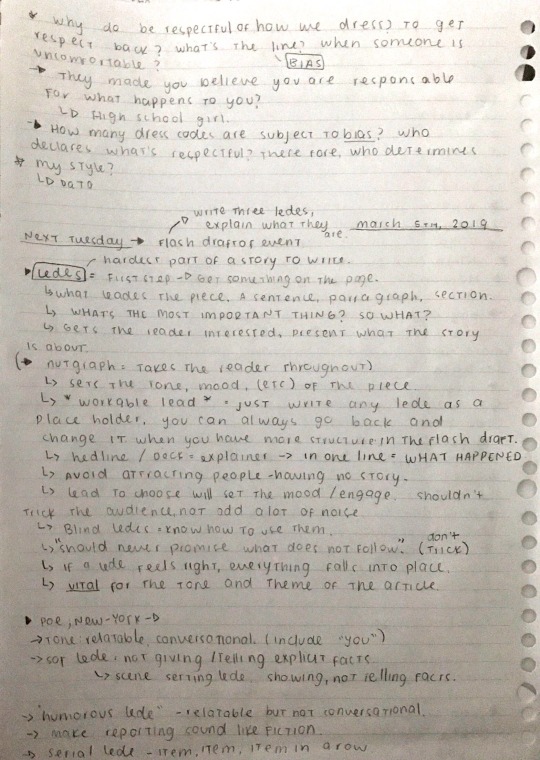Text
Assignment 11 - Event reporting: Flash Draft
Serial / Scene-setter lede:
It is 6:30 pm on a Friday winter night. After an hour-long subway and bus ride, I am now in the auditorium of the College of Mount Saint Vincent in The Bronx, waiting for “BOOM”, the dance competition, to begin. People are coming in with blue wristbands around their arms and sitting down in red semi - cushioned seats in front of a red curtain and under a big chandelier. By 7:30pm it’s almost a full house, the lights go down and the audience cheers as the host, Anthony Saks, comes into the stage, greets the public and calls “GRL”, the first piece of the night, into the stage.
Hard Lede:
The “Boom” 7th annual dance competition was held at the auditorium of the College of Mount Saint Vincent in The Bronx, New York on Friday, March 1st. The ticket was only $8 dollars which made it very affordable for anyone to go and enjoy some dancing. The dynamic of the show had both the performers and the audience filled with excitement and on the edge of their seat, as the host, Anthony Sacks, in between his (sometimes failed) attempts to liven up the energy in the room with jokes, called the crews to the stage.
Soft (final) lede:
The auditorium of the College of Mount Saint Vincent, in Bronx, New York, was quickly filling up as friends and parents of the performers came in to find their seats. The house opened half an hour earlier than anticipated because of how crowded the lobby was getting with people eager to watch the show, I could feel the excitement buzzing around me. The music DJ David Estioco was playing at what seemed to be the loudest volume possible had the energy going through the roof, setting just the right environment for an energy packed, passionate and loud dance competition, as was “BOOM”.
How “BOOM”, the dance competition lived up to its name
The auditorium of the College of Mount Saint Vincent, in Bronx, New York, was quickly filling up as friends and parents of the performers came in to find their seats. The house opened half an hour earlier than anticipated because of how crowded the lobby was getting with people eager to watch the show, I could feel the excitement buzzing around me. The music DJ David Estioco was playing at what seemed to be the loudest volume possible had the energy going through the roof, setting just the right environment for an energy packed, passionate and loud dance competition, as was “BOOM”.
13 pieces were presented. 6 competing for the trophy and 7 only showcasing their choreography. There were also three solos, one from each one of the judges who later on would choose the winner of the night. The host, Anthony Sacks, played along with the audience in between jokes, called every crew on stage. The range of styles presented was very vast, catering to almost any and every preference the audience could have. “GRL”, the first piece of the night was a very sassy and empowering heels - femme piece, and right after, “WORDS” came on stage to present a contemporary jazz performance which honored greek goddesses and mythology. “BOOM” was had innumerable energy shifts, which kept the audience in the edge of their seats.
A definite crowd pleaser of the night, was whenever one of the crews danced to a top 40’s song, which everyone seemed to know by heart. When a recognized hip hop song started blasting from the speakers, the cheering would get louder and a choir in the public would rise and sing along, connecting with the performers on stage. Cheering would also come without fail whenever there was even a glimpse of “twerking”. Any sight of it on the stage and the audience wouldn’t able to control themselves, screaming and cheering to empower the dancers, as it happened with “Calentura”, a Latin-fusion piece choreographed to Shakira’s top hits, which we all know is the perfect music to make the lower body move.
After each performance, Anthony Saks would come up to the stage and ask the dancers a few questions for the audience to get to know them better, their backgrounds and get insight on the performance. "How do you balance dance and school?”, Sacks asked to some of the High School crews, to which most of the dancers replied with a laugh that they all had a test on Monday and hadn’t studied anything at all, implying how dance is one of the most important aspects of their lives now, and how passionate and determined they are to pursue it. The out of breath answers always came followed by jokes, laughs, and hugs on stage, which showed the audience how tight the bonds that are made from creative processes can be and how through this event, young people got a new platform to support fellow artists, get inspired and push each other up.
“Project Spark”, was the winner of the night, a commercial hip - hop high school crew of more than 30 dancers who all came back on stage to lift the trophy together, as the audience cheered enthusiastically. “BOOM” lived up to its name, it was a loud night full of energy and excitement, with explosions of emotions and laughter. It opened a door to young dancers to explore their movement, take advantage of an opportunity to perform next to their friends and connect with the New York dance scene, which from what I saw at this competition, has a bright future ahead.
0 notes
Text
In class Nut Graf Assignment
https://www.vanityfair.com/news/2017/06/fyre-festival-billy-mcfarland-millennial-marketing-fiasco
FYRE FESTIVAL: ANATOMY OF A MILLENNIAL MARKETING FIASCO WAITING TO HAPPEN
Nut Graf :
“Hundreds of would-be concertgoers were experiencing the same feeling—and this was only the beginning of the end. That night, as it became clear that the festival was collapsing, they were forced to scramble to find a way back to the mainland. Many took to chronicling their plights on Facebook, Instagram, and Twitter, and that was what transformed the Fyre Festival from a failed music venue into a richly symbolic moment in Donald Trump’s deeply divided America. The Internet was ablaze in a firestorm of ridicule, with thousands of people without the money to frolic at Caribbean music festivals heaping abuse on “spoiled” millennials, who were freaking out because they were forced to sleep in tents and eat cheese sandwiches instead of sushi. “I can’t figure out what #fyrefestival is,” tweeted one, “but it seems like rich people having a bad time, which I fully support.” One woman tweeted: “I’ve always dreamed of building elaborate deathtraps that attract the 1%, but #fyrefestival actually went and did it, kudos.”
0 notes
Text
Data Assignment (Data / Human questions)
From: “The Sexualized Messages Dress Codes are Sending to Students” - The Pudding
https://pudding.cool/2019/02/dress-code-sexualization/
Data:
1. How do the dress code bans change according to each state?: Can it be more strict in the more conservative areas or no matter the set of beliefs, dress codes are set by an ingrained human ideal?
2. How many of the dress codes are subject to bias?: who sets the line of what is “appropriate” or “disruptive”, and therefore, who determines the people’s style?
3. What is the shortest skirt/shorts measurement allowed and where?
4. Who is the observer of women when the labels of “fashionable”, “erotic” or “attractive” are granted to their style of clothing, respectively?
Human:
1. Do you believe you look differently at how women dress because the dress code that was imposed in your High School presented the idea of style and clothing in a specific way?
2. Do you feel restricted to be yourself fully when your High School is oppressing an important channel of self-expression?
3. Do you feel more self-aware of your body and the way you look because of your High School dress code or because of how media portrays the body, style and figure nowadays?
4. Could a dress code impact your life in such a way that it causes eating or mental disorders or anxiety? could it create more unsafety by making each person more aware of their own and other’s physical figures, instead of creating a “safer” space, as dress codes claim to do?
0 notes
Text
Assignment 10 - Event Reporting: “BOOM”
I attended the “BOOM” 7th annual dance competition at the College of Mount Saint Vincent on Friday, March 1st at 7:20 pm.
Some notes are handwritten and some are typed, depending on how accessible it was to do either one at the moment.
(video of a performance in https://drive.google.com/drive/folders/1Wvpt5SDIOqN-cPIzzIat3y0pz3UyqhhP?usp=sharing )
Pre reporting:
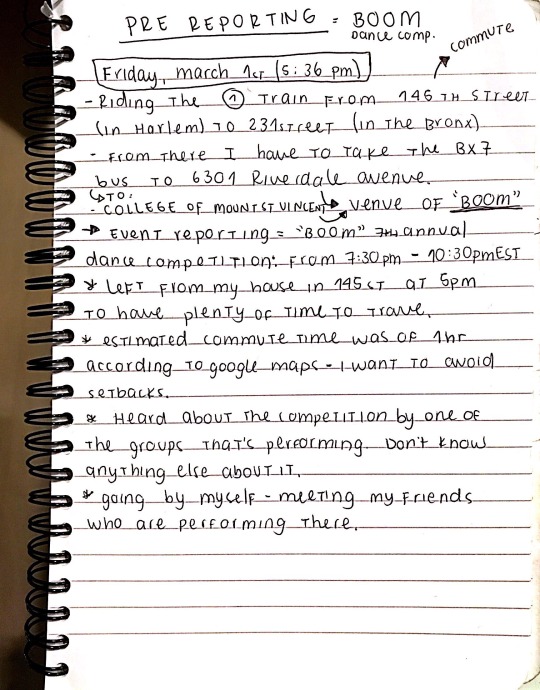
Event notes:
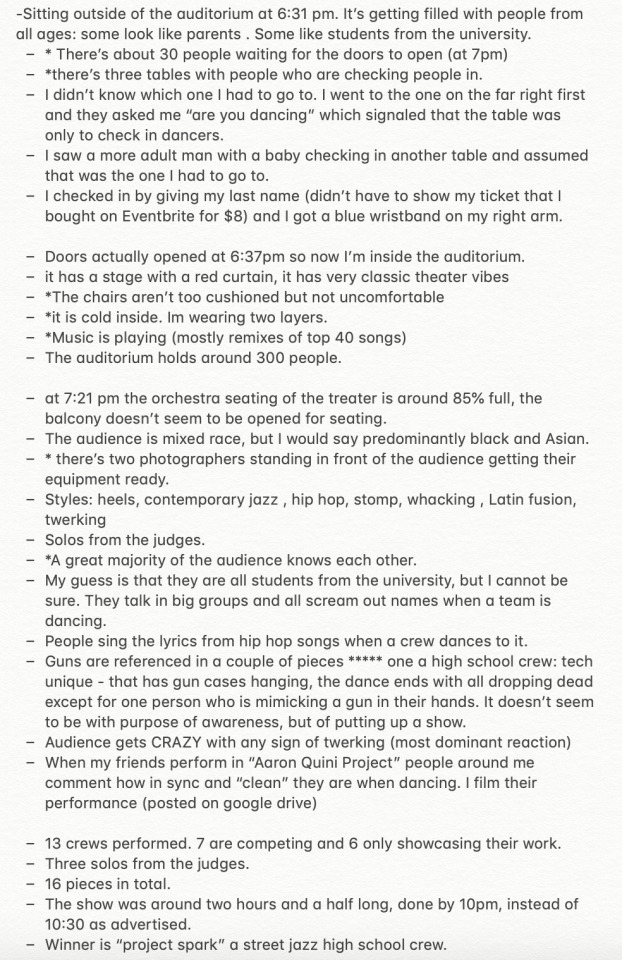
Post-show notes:
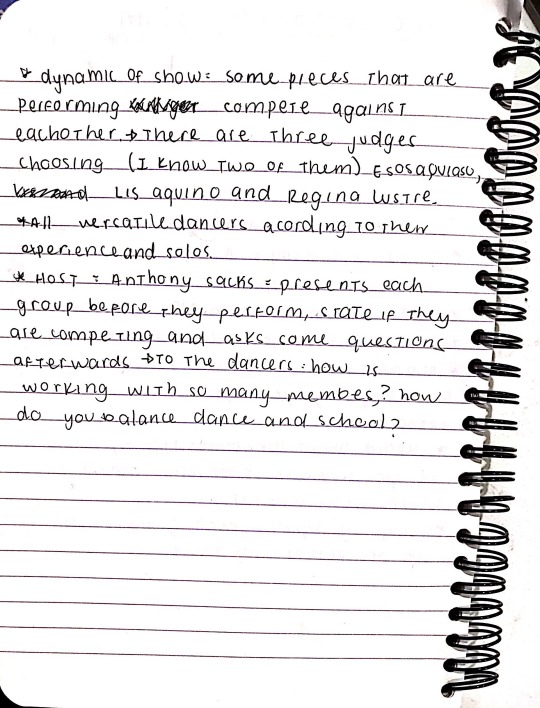
Program:

1 note
·
View note
Text
Assignment 9 - Radical Revision
Why you have to choose your nickname wisely
And how one day, it may travel the world with you
When I encountered someone whose nickname was “belly button”, I instantly had no doubt that this person was one of a kind, or at least had gone through the one of a kind type of experiences that you only hear about and are not easy to find. Chen - Chi Fang, (or Michael Fang, in English) goes by “2Chi” which stands for belly button in Chinese, since his lifelong breakdance mentor, who was fond of giving everyone different names, granted it to him after one practice back in his hometown Taichung, Taiwan, where everything started. Even though this nickname originated just from the way the syllables of his name sounded, it eventually became his brand and without anyone imagining it then, it has now left its mark all around the world.
2Chi started his artistic career as a b-boy by being part of the “Black Angle Crew”, one of the biggest breakdance crews from his city, but when he was around 15 years old he found in himself a new interest in music, which pushed him to audition for an arts-based high school. Nonetheless, as he told me while a smile appeared on his face with the memory, his singing skills weren’t very polished at the time so he couldn’t get a spot secured in the school, but that didn’t stop him. After the test, he begged his mom to sign him up for music lessons, “I just want to be a singer” he told her “I don’t know why. Just to prove myself”. Shortly afterward, he started guitar lessons and in the following audition process, made the cut.
This high school trained their students to be proficient in singing, dancing, and acting, also known as ‘triple threat’ artists, and even though 2Chi’s passion for art had been cultivated in dance, it was there where he found his love for digital music production and “DJing”. After graduation, he wanted to follow his passion and explore his artistic pathway with more freedom which is why he didn’t go to university right after, as it is commonly done, yet for a whole year he didn’t find any opportunities to showcase his work or felt much inspiration to create new material. At the sight of his son going through a rut, his dad gave him the idea to get out of his bubble and “go out and meet people, make friends, get to know the world”, in the hopes that the new and fresh sights would help him in the creative process. And it did. 2Chi then turned his childhood nickname into his brand, packed up his keyboard, put his hair up in a ponytail and sailed off to travel the world.
Throughout his journey, he has encountered many different types of cultures and weather conditions, from sunny days in Paris to the chilliest days in New York City, but what he has found the most challenging, beyond any of the creative obstacles, has been the language barriers that are created between the locals and him, a foreigner. After a month and a half of being in New York, what has struck him the most is how “people are not patient with me because of my bad English”. For him, doing anything back home in Taichung feels easier than in New York or any of the big cities, but after all, his inability to communicate properly in English may have a lot to do with his perception of how he can (or can’t) perform any activity in each place he visits.
Nonetheless, there is a positive side to him lacking communications skills and having to travel alone, since it has forced him to learn languages and find ways to communicate through whatever methods he can find. He mentioned his English improved “mostly by talking to people”, which on top of helping him practice his vocabulary, it also gets him out of his comfort zone, forces him to speak to strangers, make friends and connections.
2Chi told me his story sitting at a kitchen table on a Wednesday winter night. It is almost time for him to go back home, where his love for music started and his nickname was given to him. Even though his future seems unsure going forward, he has found many new sources of inspiration in his travels through people and experiences, which allows him to come back with ideas to develop and many stories to tell, to mold into music, to turn into art.
Maria Luisa Mejia Gutierrez
0 notes
Text
Assignment 8 - Flash Draft
If you ever encounter a person’s whose nickname is “belly button” then you must have no doubt that this person is one of a kind. This is the case of Chen - Chi Fang, (or Michael Fang, in English) who goes by “2-Chi” (Chinese for belly button) since his lifelong break dance mentor, who was fond of giving all of the members of his crew nicknames, granted it to him one day at practice back in his hometown Taichung, Taiwan. Even though it originated just from the sound of the syllables of his name, this nickname would eventually carry his brand with it around the world.
2-Chi started his artistic career with break dance, but when he was around 15 years old he found a new interest in music, which pushed him to audition for art based high school. Sadly, his singing skills weren’t very polished at the time, which stopped him from getting a spot secured in the school, but that didn’t stop him. After the test, he begged his mom to sign him up for music lessons, he told her: “I just want to be a singer, I don’t know why. Just to prove myself”. Shortly afterward, he began with guitar lessons and in the following audition process, made the cut.
In high school, he was trained to be a triple threat artist, but it was there where he found his love for digital music production and “DJing”. After graduation, he wanted to follow his passion and explore his artistic pathway with more freedom, yet for a whole year, he didn’t find any opportunities to showcase his work or much inspiration to create new material. At the sight of his son going through an inspiration rut, his dad gave him the option to get out of his bubble and “go out and meet people, make friends, get to know the world”, in the hopes that the new and fresh sights would help him in the creative process. And it did.
2-Chi turned his childhood nickname into his artistic name and sailed off to travel the world, with the intention to create new material wherever he went with any material he could find. He realized how important music videos are to promote new work, so he taught himself the basics of video production through YouTube videos and tutorials, as he said to me “I had no team so I had to learn how to do it myself”.
He has stormed through all types of cultures and weather conditions, but what has challenged him the most, beyond any of the creative obstacles, has been the language barriers that are created whenever he is considered to be a foreigner. After a month and a half of being in New York, two things have struck him are the fact that “the subway is very dirty” and how “people are not patient with because of my bad English”. For him, doing anything in Taiwan feels easier and more convenient than in New York or any of the big cities, but after all, his inability to communicate properly in English may have a lot of weight in his perception of each place he visits.
Nonetheless, there is a positive side to the lack of communications skills and having to travel alone, because it has forced him to learn the languages through whatever methods he can find. He has improved “mostly by talking to people”, which not only helps him communicate but also gets him out of his comfort zone, forces him to speak to strangers, make friends and connections.
2-Chi told me this story, sitting at a kitchen table on a Wednesday winter night. He mentioned how it is almost time for him to go back home, where his love for music started and his nickname was granted. Even though there is nothing clear for him in the future, he has found many new sources of inspiration through people and experiences and comes back with stories to tell. He will come back and try to “put his music and his dance together”, his two childhood passions, and will continue to create very special content, just as his nickname.
0 notes
Photo

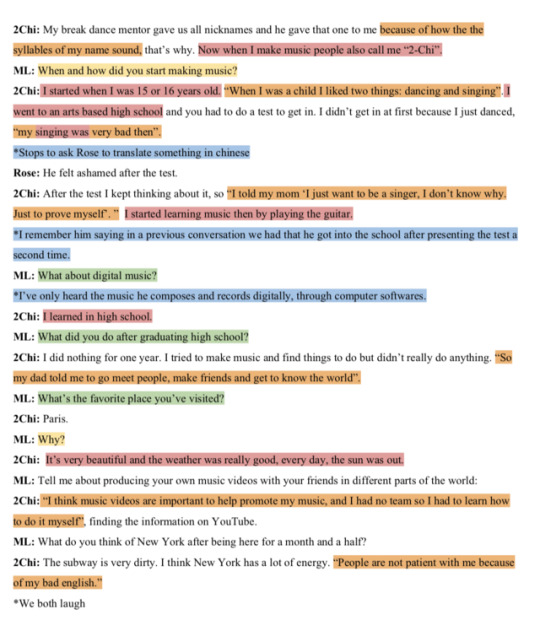

INTERVIEW WITH 2-CHI: Transcript
Orange: Quotes-- your favorites (threads to build your piece)
Yellow: Clarity (I’m confused, help me out)
Green: Follow-ups (I’m curious, tell me more!)
Pink: Facts (how do we know this? Source? too good to be true - ie, fact-checking needed)
Blue: Observation (what is the person wearing, how is she talking? how does she walk? etc)
0 notes
Photo


Assignment 6 - Interview (notes)
notes of my interview with Michael (Chen - Chi) Fang. Wednesday, February 13th, 2019. 10:15pm.
0 notes
Photo


Assignment 5 - Notes on “News Writing” (The Guardian)
These are the notes I took while reading the article, which I realized mostly deconstructed what good journalistic pieces should be like, such as the language that should be used/avoided and the questions that the writer has to aim to answer in each piece.
What will stick with me the most is how important is the use of simple language, because I’ve realized sometimes my writing is unnecessarily long, in times where the same thing could’ve been said in a very come concrete and “straight forward” way.
Also, I will keep in mind the concept of the “five W” that should be addressed in each piece, and how writers should put themselves in the position of the readers to make sure their message is coming across effectively.
0 notes
Link
After going back to Colombia, my home country, during the holidays, I realized how bad the situation in Venezuela is. The streets of my city have dozens of Venezuelan people asking for help, playing music, begging or even giving away their own currency since it has become worthless. I believe it is very important for people to know about this situation everywhere in the world since it is considered to be the fastest drop in what was a very wealthy nation in history. I like how this article presents the news because it is concise and makes sure to explain all the facts that many may not know by not being so close to the action. Also, I appreciate they have so many links to redirect the reader to other articles that explain more thoroughly one specific detail of the series of events.
0 notes
Photo

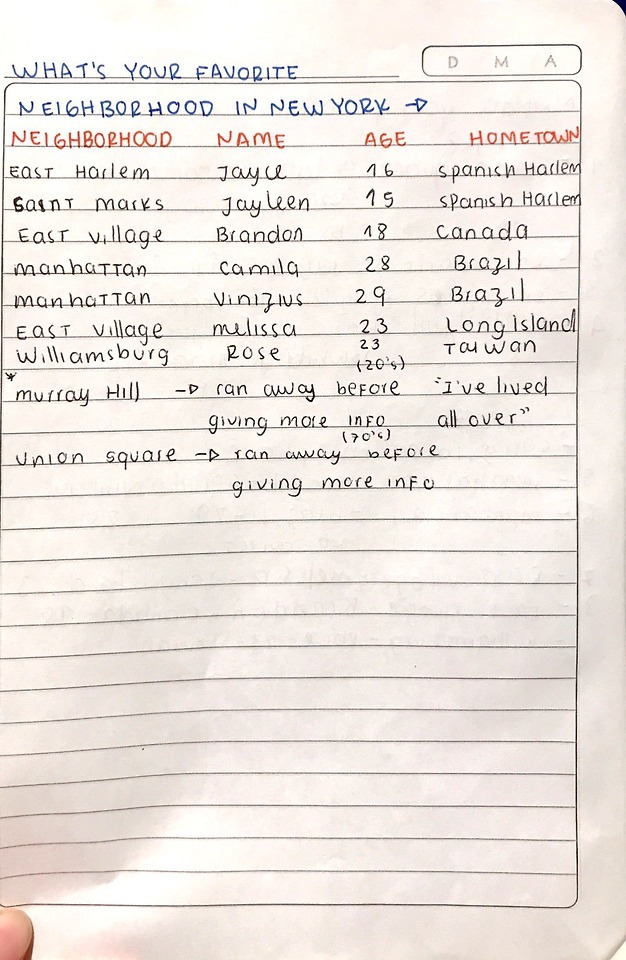
Assignment # 4 - Vox Pop
Here are my notes with the answers I gathered after asking the question “What is your favorite neighborhood in New York City. First is the picture of the notes I was taking while asking people around (which is why they are very messy) and the second one is a more organized dataset with all the information.
0 notes
Text
In class assignment - story ideas for Kristen’s map:
There are not a lot of details about what was going on at the moment she was in the park. There is signaling of landmarks in the park as well as the names of the streets around it.
1) Compare what goes on in the streets that surround the park at different times of the day (morning, noon, night) and annotate which types of people would go to the park from each one of these, and at what times.
2) Get into the design of the “green spaces” (gardens) of the park. Research who designed the layout and if there was a purpose to it.
3) Do a profile on people that go to the dog park and their relationship with their dogs, more specifically, how these may vary according to the characteristics of the owner and the breed of the dog.
0 notes
Text
Assignment # 3: Reaction text
Maria Luisa Mejia
January 31st, 2019
If I had to give an example of what good design is today, my answers would be completely different from the ones I gave before reading both of these texts. As I read I understood that an object with good design should aim to make people’s lives easier without any “need for trial and error” (Norman, 2), it should be purposeful and aim for utility, not beauty. It should communicate the right messages to the user and avoid confusion at all costs. Overall, it should provide an easy interaction between the user and the object.
These, are a few qualities of good design that I annotated form Munari and Norman’s text, and I think these all come together in a concept that the latter calls Human Centered Design, which according to him is one that aims to work with both technology and psychology together. It is a design that puts human needs first and above everything else.
I gathered from both texts that the usefulness of an object is the designer’s responsibility, which seems like a very extreme idea considering that many other professionals are involved in the creation processes, but I do agree that appearances are what attract people to look at an object and the impression they will keep of it comes from how pleasurable their experience was with it, and both of these are tied to the designer’s job.
It is very hard to keep our attention these days, especially if we have to work to understand what we are looking at. Because of this, designers have to find ways to feed us the information in the most effortless way possible. I understand this lies a lot of responsibility on them, but the satisfaction of achieving it must feel like the greatest reward, in a world where everything is so immediate that no one can really keep anyone’s attention for more than a few seconds.
0 notes
Photo

Assignment # 2: Explore Washington Square
A) Here is a hand-drawn map of the square as it was on Saturday, January 26th at around 5:30 pm. 33*F / 1*C
B) A few ideas to write about:
1. Talk to the members of the jazz band that was playing on the park and do a profile on them. Ask why they chose to play outdoors on a specially cold winter evening when there are not many people around? How often they do it and if they consider it to be a successful strategy to get the people’s attention? Build a schedule on their performances all year round.
2. Present “The Stranger’s Project” - a compilation of personal letters written anonymously and published in books and social media for people to read. I would talk to the creator and ask him how the whole project started and what inspired him to do such a thing. Also, talk to the people who read these letters and gather opinions on why it is so enjoyable to read other people’s stories when they seem the most vulnerable.
*most people who were in the park at the time were around “The stranger’s project” stand, reading the few letters they had displayed.
3. Write about the young skater community in New York City. Why do they usually gather at Washington Square, even when the weather conditions aren’t the most favorable for skating? what makes it a preferred location?
4. Compare Washington Square through different weather conditions and seasons. I didn’t hear many languages being spoken around me which tells me not many tourists go to the Square in the winter so I would question if there should be something that attracted people all year round?
0 notes
Link
I believe this video is journalism because it is giving context, information, and opinions about a current situation in the world. Even though it is not narrating one specific event, such as one manifestation or shooting, the gathering of clips and smaller scale news create one good source of knowledge for anyone who may be interested in knowing about the state of Venezuela. I believe it is a very effective video because it tells most of the important aspects of the story without going too deep into details, which allows them to stay in a neutral area and not show bias, letting the audience perceive the story as they may.
0 notes

